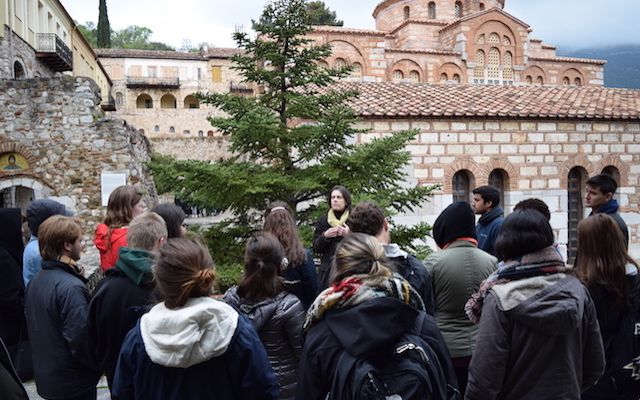
Intense experiences for both tutors and students
By DIMITRA KOTOULA*
Experiencing learning and on-site teaching with immediate contact with the subject and the artifacts under discussion can be a particularly intense experience for both tutors and students.
I joined the CYA community in Spring 2009. Having just returned from London and the Courtauld Institute of Art, I was struggling with little success, I confess, to adjust, build a new life and career in Athens: it was evident that a massive crisis was on the horizon.
Teaching at CYA as an Art History Professor specializing in Byzantine History, Archaeology and Art, had a profound impact in enhancing my professional skills, as well as -I believe- the curriculum and educational experience of my students.
Together we revisited, in a series of class meetings and on-site/museum visits, aspects of the cult and culture of the millennium-long empire of the Roman/Byzantines that remains largely alive, especially in the Eastern Mediterranean.
During one of the iconoclastic debates that we had in class, the iconoclastic group used as argument for the prohibition of the cult of the icons extremities in veneration practices such as eating or drinking parts of icons. Later in the semester, during our walk in the Byzantine churches of the Plaka region, below the Acropolis, we happened to witness an old lady inside a church venerating an icon, and, then, quietly, withdrawing in the narthex, scrubbing the lower part of the frescoed image of a saint and tasting it. The ‘iconoclasts’ were astonished: ‘Professor, she is actually eating the icon!’, exclaimed. They could not believe that what they had fervently argued about in class!
Experiencing learning and on-site teaching with immediate contact with the subject and the artifacts under discussion can be a particularly intense experience for both tutors and students.
* Dimitra Kotoula studied History and Archaeology at the University of Ioannina, Greece and the Courtauld Institute of Art, London. She holds a Masters and PhD in the History of Art with a field of specialization in Byzantine Art. She has taught on Byzantine Art and Archaeology, as well as the cultural interchanges between Byzantium and the West at the University of Thessaly in Greece and at The Courtauld Institute of Art in the UK. She has lectured and published on issues of form and function in Byzantine archaeology and art (with particular emphasis on eschatology), cross-cultural exchanges in the Mediterranean basin during the 15th and the 16th centuries, as well as 19th-century perceptions of Byzantium. Her research has been sponsored by the Seeger Centre for Hellenic Studies, Princeton University, the Dumbarton Oaks Centre, Washington DC, the Kunsthistorisches Institute, Florence, the Academy of Arts, Letters and Science, Venice and the British Academy. She has worked as a research associate at the British School at Athens (Byzantine Research and Publication Fund Archive).





